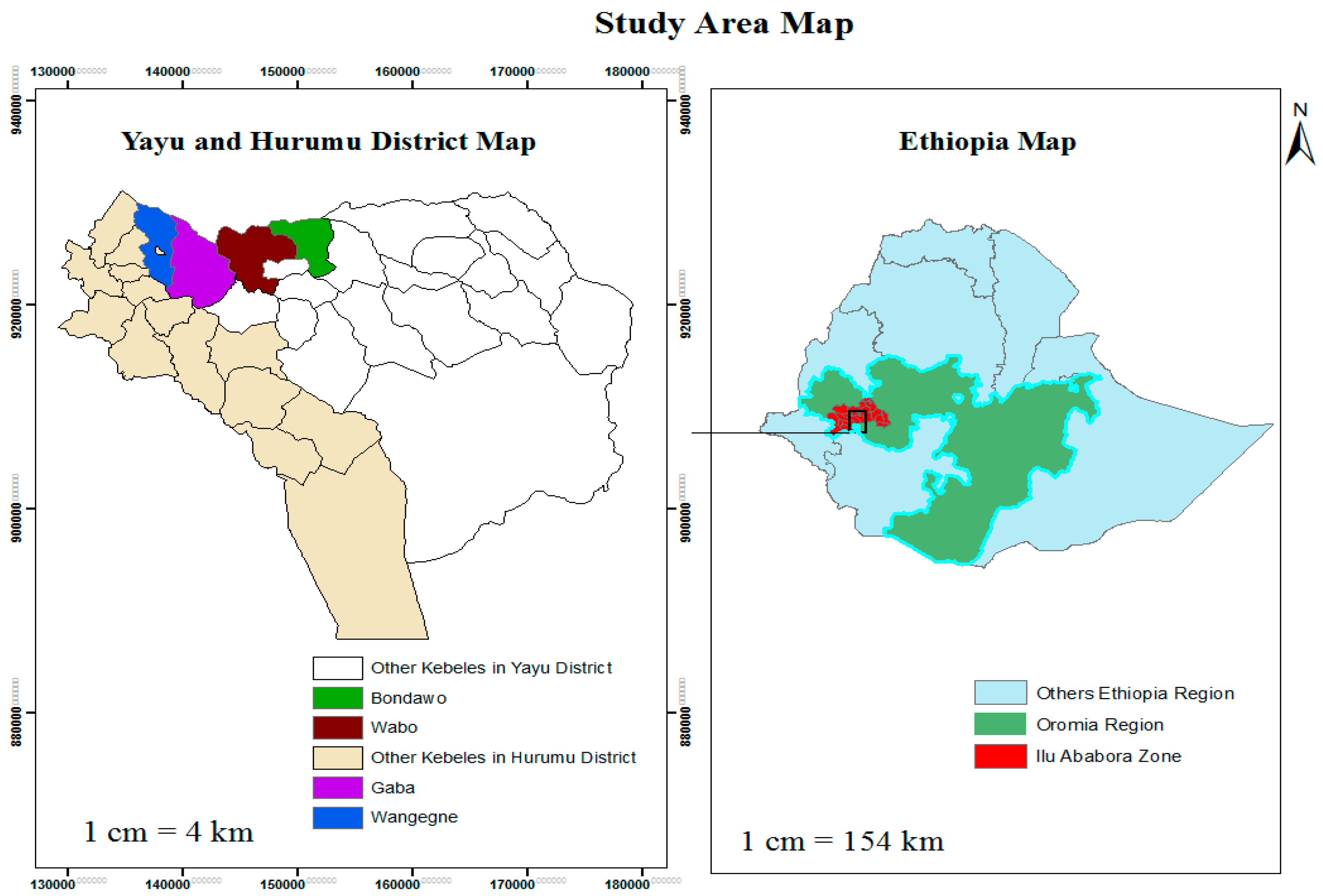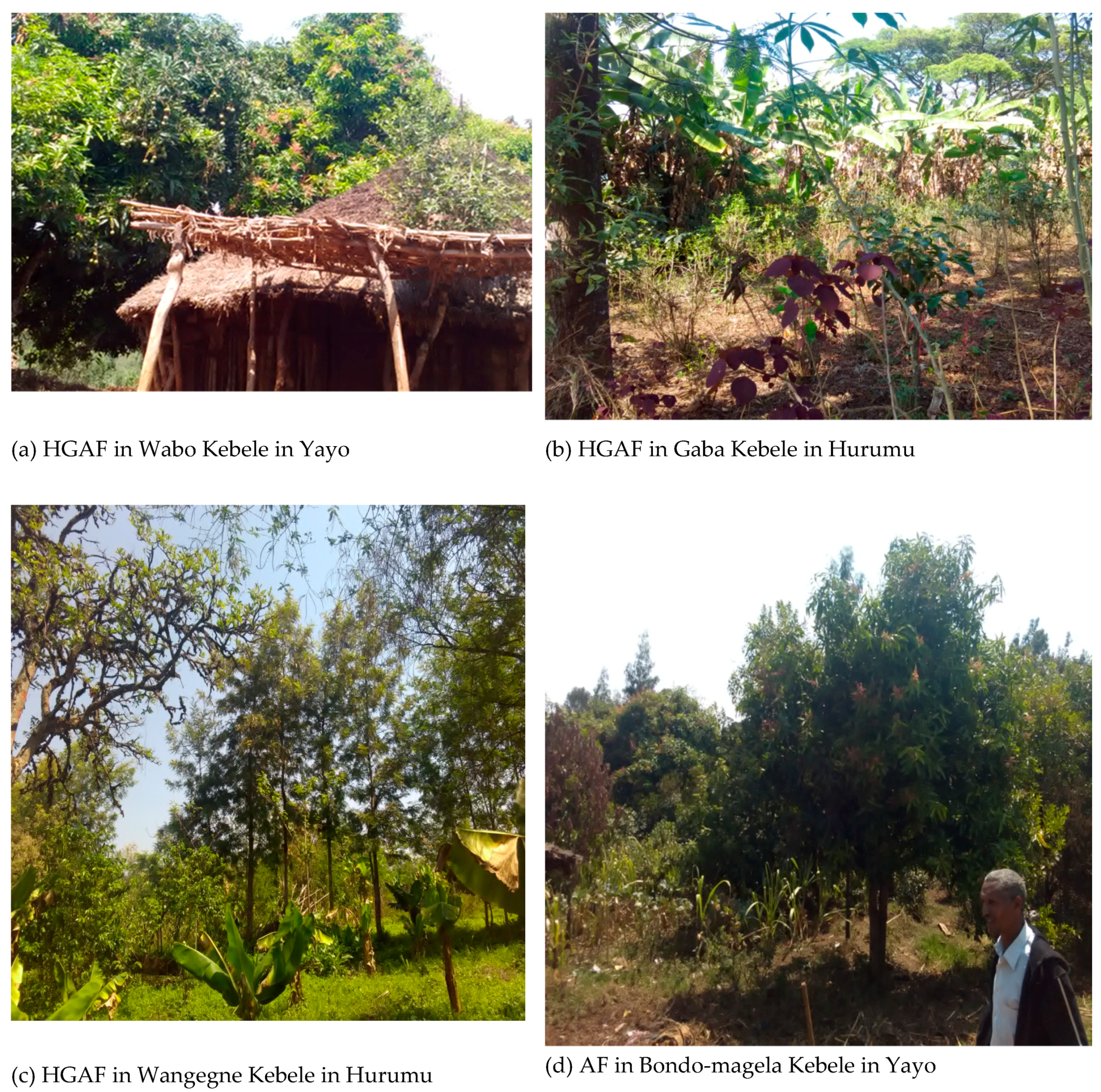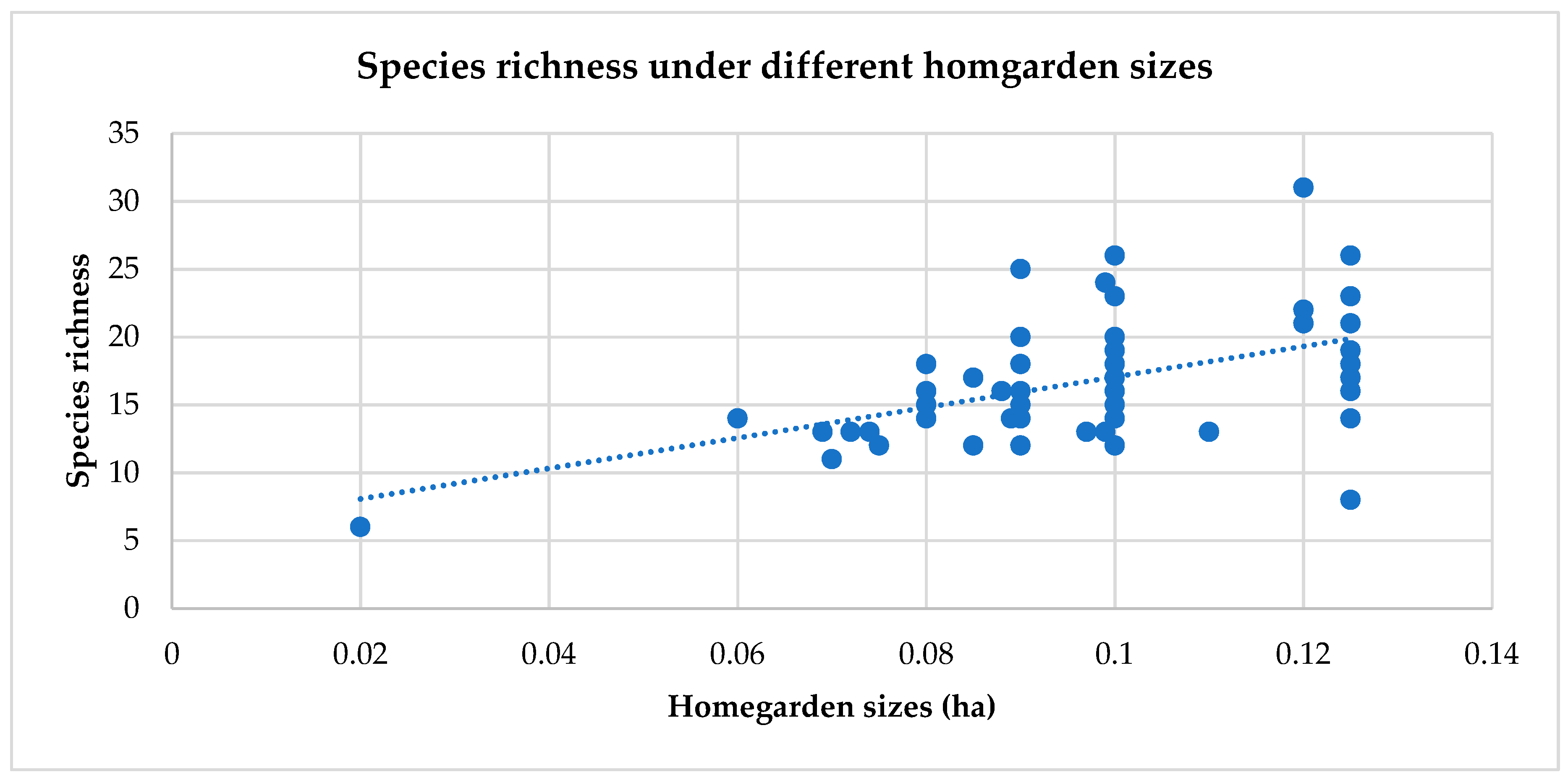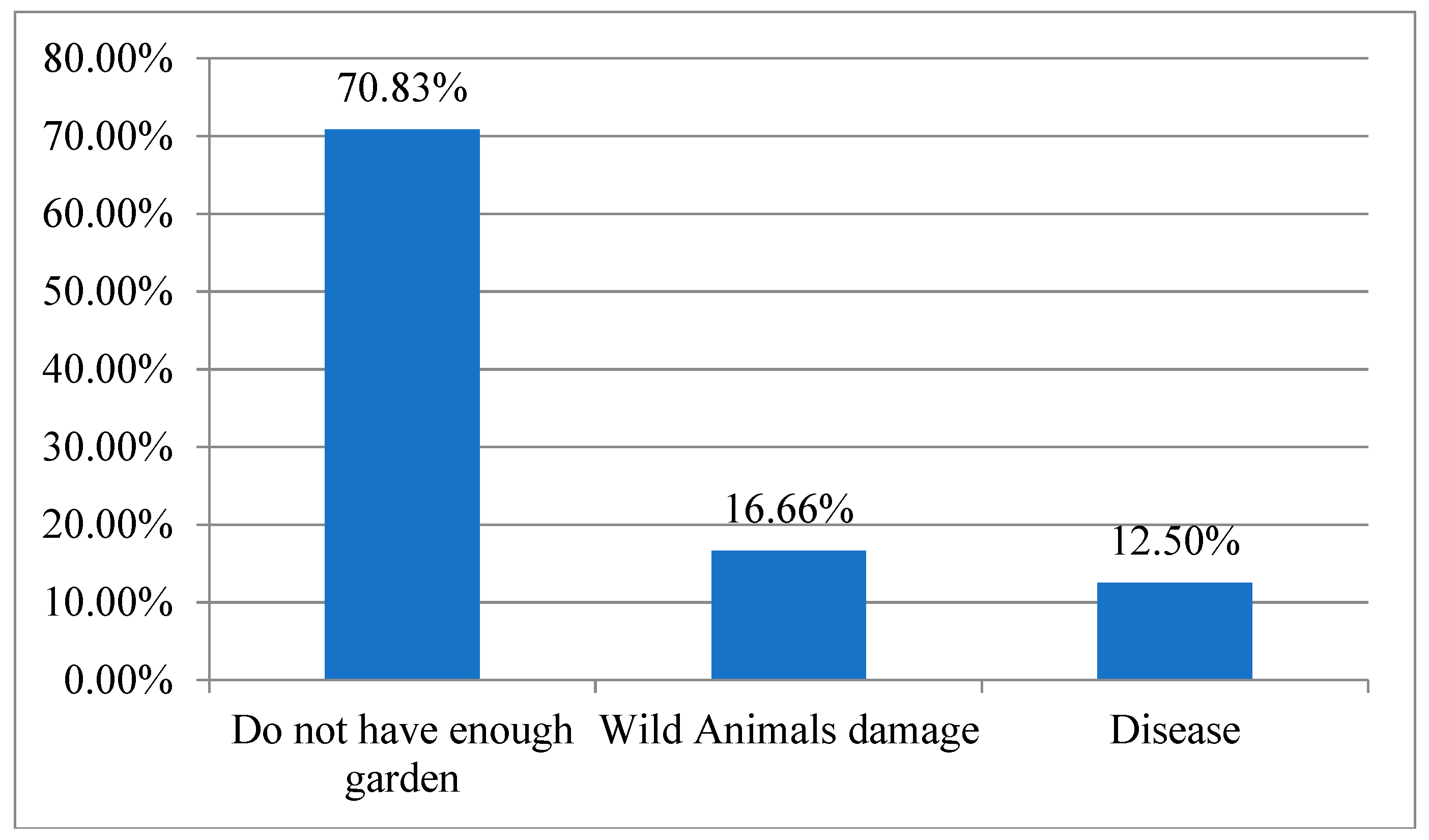3.1. Plant Diversity Assessment of Homegardens
All of the surveyed homegardens were between 8–69 years old, and had a size ranging between 200–1250 m
2. A total of 76 species were recorded and identified in the sample homegardens with a maximum number of 31 and a minimum of eight species recorded in fruit and vegetable user households’ homegardens (
Table 1). This result is smaller than the maximum number of species (51) reported for homegardens from Benin, a West African country [
32]. Out of the 38 families identified, the five most frequent families were Euphorbiaceae, Fabaceae, Lamiaceae, Rutaceae, and Myrtaceae. In total, 13 fruit species, which accounted for 17.1% of the total species and eight (10.52%) vegetable species were found in the homegardens of the study area. Similarly, the same numbers of fruit species (13) were reported by another study on homegardens of Bangladesh [
18], while 31 fruit species were found in the homegardens of northern Thailand [
33].
The result of the overall Shannon Wiener diversity index value that was calculated was 3.15. This result indicated that the homegarden system of the study area was characterized by high species evenness and richness.
The species evenness that was calculated was higher for FVU (
E = 0.81) than for VOU (
E = 0.68) (
Table 1), indicating a more even distribution in FVU homegardens.
While we found no correlation between species richness and the age of the HG owner or the age of the HG, the HG size was significantly correlated to plant species richness, with a higher species richness in larger than in smaller-sized homegardens (
p < 0.01) (
Figure 3). This might be because smallholder farmers tend to focus on fewer species of larger value and allocate more of their land to food crops, while large holders can afford to include different types of plant species, including fruits.
We attribute this to the tendency of large HG owners to grow fruit trees, while households with smaller HGs prefer to cultivate annual vegetables, which take a much shorter period of time to reach the harvesting period than fruit trees. About 71% of the VOU respondents considered the small size of their homegarden a reason for not growing any fruit (
Figure 4). This result is in line with the conclusion from Degnet [
22], stating that poorer families with less land holdings tend to have smaller homegardens, and as a consequence lower levels of diversity. The increase in species richness with increasing homegarden size was also reported by other studies on homegardens [
19].
3.2. The Contribution of Fruits and Vegetables to Livelihoods
Most questionnaire respondents indicated that fruits and vegetables are contributing to their food safety, with 55.56% of respondents ranking the importance of fruits and vegetables in the households’ food intake as high, 32% ranking their importance as medium, and 12.34% ranking their importance as low.
Regardless of their wealth status, the respondents named fruits and vegetables as an important contributor to overall household food consumption and as particularly important for the food security of children in times of other crop shortages (two-tailed Chi-square test
p = 0.66,
X2 = 2.38, df = 4). This result is in line with a study conducted in northwestern Ethiopia [
14], which stated that fruits play an important role in improving household nutritional security for at-risk populations, particularly women and children, especially during times of famine. Based on the existing literature, [
34] Deribe drew the conclusion that vegetables and fruits contribute considerably to nutrition and food security.
Apart from work as an employee, we identified coffee, maize, Khat (Catha edulis (Vahl) Forssk. ex Endl.), livestock, fruits, and vegetables as major income sources in the study area.
The results indicated that coffee is the major source of income for all wealth categories, accounting for 52.43%, 68.27%, and 65.01% of the mean annual income for rich, medium, and poor households, respectively. This result confirms previous studies [
17,
19] highlighting coffee as the major cash crop in the area, followed by khat.
Wage was the second most important, while livestock was the least important income source for poor households. Income from maize, khat, and livestock was lower for poor households than for medium and rich households, but wage income was higher for poor households than medium-wealth households. This might be due to the tendency of poor households to engage more often in wage labor or off-farm activities to overcome their income shortage.
The sale of fruits and vegetables contributed on average 7% to the total income, contributing to a significant difference between the income of households with and without the marketing of fruits and vegetables (
p < 0.01). However, the importance of the income from fruits and vegetables varied across the different wealth classes, with only 4.09% of rich, 7.12% of the medium wealthy, and 12.7% of poor farmers considering them important. Overall, we found fruits contributing more income than vegetables across all of the wealth classes, making up 7.58% of the mean total annual income of poor households and 2.41% of rich households (
Table 2). Income from vegetables remained rather low, at 2.88% for rich households and 1.68% for poor households.
While income from fruits did not differ significantly between the kebeles (F = 0.46, df = 3, p = 0.708), income from vegetables was significantly lower in the Wabo and Bondo kebeles (406.25 ± 125.6) than the Gaba and Wangegne kebeles (p < 0.05). Accordingly, there was no significant difference within the same district in terms of fruit and vegetable income, but there was a significant difference between the two districts (Yayo and Hurumu). In other words, the Hurumu district received more annual income from fruits and vegetables than the Yayo district. This might be a direct result of the observed higher prevalence of vegetables and the availability of small-scale irrigation systems in the Hurumu district. In addition to this, there is a relatively better market access in the two kebeles of Hurumu, which is mainly due to the short distance to the markets of Hurumu and Metu.
Our results indicated that fruits and vegetables have the potential to contribute substantially to household livelihood. However, different challenges might limit the full productive potential of the homegardens.
Plant diseases, pests, and associated fruit abortions were the most important problems reported by 39.6% of the respondents during individual interviews and FGDs (
Table 3). Citrus leaf and fruit spot, fruit rot, anthracnose, and bacterial soft rot were the most commonly reported fruit and vegetable diseases affecting fruits such as mango, papaya, lemon, kashmir, and vegetables such as cabbage, pepper, tomato, and potato. Similar diseases and pest problems have been reported, e.g., in the Kafa zone of southwestern Ethiopia [
35]. Farmers often employ traditional farming practices such as the application of ashes and the removal of infected fruits and branches to manage diseases and pests. However, chemical treatments, including the application of insecticides, pesticides, or other more sophisticated and ecological integrated pest management strategies are lacking.
Wildlife damage was another important challenge for growing fruits and vegetables; it was highlighted by 19.8% of the respondents (
Table 4). Monkeys and birds feed on fruits and cause physical damage to fruit trees, which in turn causes a yield reduction for the following years. The study Zewudie [
36] also reported crop destruction by wild animals in Yayo and Hurumu, and emphasized that a substantial portion of the crops of the area is usually damaged by wild animals such as bush pigs, Columbus baboons, and other monkeys. Personal observation also confirmed this situation in the area.
Market access was considered to be a major challenge by about 16.7% of the respondents (
Table 3), including markets for buying supplies and selling their products. Due to these challenges, farmers are often discouraged from cultivating fruits and vegetables. Similar findings were also reported by Katja [
37], who argued that poor market access encouraged subsistence-orientated production. In addition, as it was also discussed in Tefera [
38], low market return and access may also cause farmers to grow only a few cash crops; we can see this in the study area in terms of coffee and khat expansion, which in turn has a negative impact on the biodiversity of homegardens. However, for poor farmers, fruits and vegetables may provide an important source of food and nutrition security, even under difficult conditions for marketing this product. Other studies have confirmed our results and reported that agricultural products other than coffee and honey are less marketed and mostly consumed at the household level [
39].
3.3. Effects of Homegardens on Household Forest Dependence and Nature Conservation
About 37.5% of respondents confirmed that they regularly harvest different forest products to meet their household needs such as fuel wood, forest coffee, fibers, and spices. Forest coffee and firewood were the two most important forest products harvested (63.9%) for local households, followed by spices and lianas (16.7%).
However, the majority of forest resource-dependent households (88.2%) were VOU households. This might be a consequence of the higher income and food security of fruit-growing households compared to other households. FVU relied significantly less on forest products than VOU, and showed significantly lower levels of nearby forest harvesting (r = −0.566, p < 0.01).
The majority (76.04%) of the respondents indicated that the planting of trees in their homegarden was a direct consequence of the declaration of the biosphere reserve and the resulting shortage of fuel wood, construction, and fencing materials. They also reported using fruit and other trees in their homegardens as a source for food, timber, and firewood, which replaced the most important products harvested from the forest. Our results indicate the importance of homegardens, specifically of fruit trees, to alleviate pressures from nearby forests as a source for wood, fiber, and other forest products.
The study Utpal [
40] from Canada reported that the distance of a village from the next forest site highly affected the utilization of timber or non-timber products as a result of increasing time requirements and work force to collect the products with increasing distance. In this study, only 18.33% of respondents indicated that the long distance was their reason for not harvesting products from the forest, while the majority (61.66%) agreed that they substitute forest products with resources from their own farms. Only a minority of respondents reasoned that the forest is legally protected (10%) or that the resources can be accessed through local markets or sharing with their neighborhood (10%). This result indicates the important role of agroforestry systems in minimizing pressure on protected areas and natural forests. The main objective of the protection of the biosphere reserve is to maintain biodiversity and decrease the pressures exerted by the local community in the natural areas. It also encourages the sustainable use of natural resources without adversely affecting the biosphere reserve. However, food and income shortages have forced local communities to harvest natural forests and violate protected areas.
The results in this study highlight the important role of fruits and vegetables in plant biodiversity conservation and household livelihoods in terms of food and income generation. Fruits and vegetables have the potential to provide both food and income, thereby substituting resources that were previously harvested from natural forests. Therefore, an extension of the fruit and vegetable production in homegardens may have the potential to lower the pressures on natural forests, thereby improving the sustainable use of biodiversity in the biosphere reserves.









